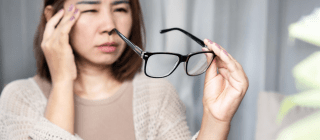Watch Out For 10 Common Vision Problems

Learn what causes the 10 most common vision issues, how to recognize them early, and what you can do to protect your sight.
From the moment we wake up in the morning until we turn out the lights at night, we depend on our vision. It’s critical for perceiving the world around us and helping us successfully navigate through it.
Our eyes work so well that we may take them for granted, until something goes wrong. When we can no longer see clearly, we tend to become disoriented and daily tasks become more difficult. Impaired vision can increase the risk of accidents and lead to a decline in overall health. People who have trouble seeing may become socially isolated and depressed.
To protect your vision, it’s important to learn about common vision problems and what you can do to prevent them. Here’s a breakdown of 10 common vision problems:
- Age-related macular degeneration — This eye disease mostly occurs in people over the age of 50. The macula, the central part of the retina (the area in the back of eye that captures light images), begins to deteriorate. People with macular degeneration may have difficulty seeing in low light, blurred vision, or problems seeing colors. Straight lines may appear wavy or curved. There may be blank or dark spots in the field of vision. There is no cure, but medications, nutritional supplements, and other treatments can slow its progression. Eye exams can find the disease in its early stages, when treatment is most effective.
Cataracts — The lens of the eye (which helps focus light) becomes cloudy when cataracts develop. Over time, vision can become blurry or hazy. Colors may look faded and night vision can be diminished. Cataracts can start to form after age 40 and get worse as you age. If cataracts are beginning to impair activities such as reading or driving, the clouded lens can be removed with surgery and replaced with a clear artificial lens. Cataract surgery is not painful, as drops are used to numb the eye during the procedure. Protecting your eyes from the sun by wearing sunglasses that block ultraviolet light will help prevent cataracts. Check out our blog post on choosing the best sunglasses.
Diabetic retinopathy — High blood sugar from diabetes can cause changes in the blood vessels that go to the retina. The blood vessels may become blocked, causing them to bleed into the fluid that fills the eye. People may see dark, floating spots or streaks. A sudden increase in floaters (see below) can be a sign of diabetic retinopathy. To prevent this condition, manage your diabetes to keep blood sugar levels in a healthy range. Diabetic retinopathy can be treated with medications and laser procedures to slow progression of the disease.
Dry eye — When your eyes don’t make enough tears, they may feel scratchy, sting, or burn. They may be red and sensitive to light. You could also have blurry vision. Over-the-counter eye drops or prescription medications can relieve dry eye. Lifestyle changes can also help, such as limiting screen time and taking frequent breaks, wearing wraparound sunglasses when outside, and making sure you are well hydrated. Learn more about how to stay hydrated in the summer.
Eyestrain — Your eyes feel tired and sore when you overuse them, such as after driving long distances or looking at a computer screen for extended periods. If your eyes work hard to focus because your glasses or contacts prescription is out of date, that can also lead to eyestrain. To prevent eyestrain, take frequent breaks from looking at screens, make sure the room is well lit, and minimize screen glare by repositioning lights so they don’t reflect off your screen. If you wear glasses or contacts, get an eye exam to ensure your prescription is current and if necessary, update your eyewear to the new prescription.
Floaters — As you age, strands in the fluid that fills your eye stick together. They can cast shadows on the retina, which appear to you as small dark shapes that float. Floaters tend to come and go, and they usually don’t require treatment. However, floaters can be a sign of a more serious eye problem. If you are experiencing frequent floaters, get an eye exam to determine if there is an underlying problem.
Glaucoma — When passages in the eye that allow fluid to drain become blocked, the buildup of fluid can cause pressure inside the eye to increase. Higher pressure can permanently damage the optic nerve that sends images to the brain, resulting in vision loss and possibly blindness. Glaucoma can begin at any age but usually affects people over 60. There is no cure for glaucoma, but medications and laser treatments can be effective in lowering eye pressure and slowing progression of the disease. Glaucoma often does not have any symptoms, so most people don’t know they have it until optic nerve damage has occurred. Glaucoma can’t be prevented, but regular eye exams can detect it early before the disease causes significant damage.
Irritation — There are many things that can cause your eyes to become irritated, feeling like they are itchy or burning. They include allergies, infections, dry eye, smoke and dust in the air, eyestrain, and improper use and cleaning of contacts. Blepharitis, a condition that causes inflammation of the eyelids, can lead to eye irritation. Styes, which are small, painful, pus-filled bumps on the eyelids are also sources of irritation. To prevent eye irritation, take allergy medication when needed, avoid environmental irritants like smoke, take frequent breaks from looking at screens, and follow proper procedures for cleaning and wearing contacts. If your eyes become irritated, applying eye drops and a cool compress can help. To treat a stye, apply warm compresses and then gently massage the eyelid. Also keep the eyelid clean and avoid touching or rubbing the stye. As with all sources of eye irritation, if it doesn’t improve or is very painful, contact your eye doctor.
- Pink eye — Conjunctivitis, also known as pink eye, is a condition that causes the inside of the eyelid and the white part of the eye to swell and become pink or red. The eye can also feel itchy or burning and may water. There can be a fluid discharge and you may have crust form along your eyelids. Pink eye is often caused by a virus or bacteria and it can easily spread from person to person. To prevent pink eye, wash your hands often and don’t share items with someone who has pink eye, including pillows, towels, and makeup. Pink eye often gets better after a week to 10 days. Use cold compresses and over-the-counter eye drops to ease the symptoms. If your symptoms don’t improve after a few days, if you have a lot of pain, or your eye is very red, contact your eye doctor.
- . Retinal detachment — When some of your retina is pulled out of its normal position, such as from an eye injury, you may see new floaters, flashes of light, or a dark shadow on the sides or middle of your vision. It can happen quickly and needs immediate treatment, before more of the retina detaches and the risk of permanent vision loss increases. If you suspect your retina may have detached, contact your eye doctor right away or go to the emergency department. To prevent retinal detachment, use protective eyewear during sports and other activities. Also, get regular eye exams, which can find small retinal tears or detachments early.
How Often Should You Get an Eye Exam?
Many common vision problems can be detected early or prevented by having eye exams on a regular schedule. Most adults in good health should have a comprehensive eye exam at least every two years. However, people ages 65 or older should see their eye doctor annually. If you have certain medical conditions, or an increased risk of eye diseases, your doctor may recommend more frequent exams. Check your health plan’s outline of coverage to see if eye exams are covered. You can also purchase individual vision plans.
Our Find-a-Doctor tool can help you locate an eye doctor near you. Check out our blog to learn more about how to keep your vision healthy.



